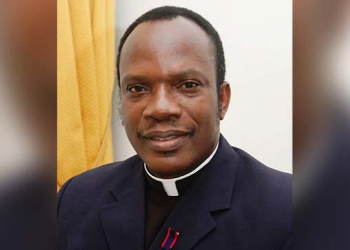It’s a cold, rainy morning in South London, and Lynette Yiadom-Boakye, wearing jeans and fluffy slippers, is stirring a pot of homemade porridge. There’s an easy confidence about her, a welcoming warmth and humor. Her duplex garden flat is a cozy mix of elements that don’t belong together but get along just fine—bold patterns, busy wallpapers (lots of flowers and birds), strange old pieces of furniture. The house is not far from where she grew up. “I always thought I’d end up living somewhere else,” she tells me, “but I really love it here.”
There’s a photographic print on the sitting-room wall by her friend Lorna Simpson. “I didn’t understand the joy of owning artworks until I put Lorna’s piece up,” she says. But I don’t see any other art in the house, and not a trace of Lynette’s own work. Her hauntingly powerful paintings of black men and women, every one of them fictional, have been attracting more and more attention in the last few years. She was shortlisted for the 2013 Turner Prize and has recently had solo exhibitions at the Serpentine Gallery in London, the Haus der Kunst in Munich, and the Kunsthalle in Basel. Next month, a show of her work will open at New York’s New Museum.
“If you walked into a room with a thousand people in it, and one of the people in her paintings was there, that’s who you’d want to meet,” says her friend the designer Duro Olowu. Most are large-scale, single-figure studies whose faces, set against loosely brushed dark backgrounds, look directly at the viewer. In some, only the whiteness of eyes and teeth pulls them back from near invisibility, but the effort of looking makes them seem all the more real. They have the gravitas and authority of nineteenth-century portraits, shorn of domestic detail—nothing to distract you from the invented yet intensely alive subject. John Currin uses old-master techniques to enrich his contemporary figures. Lynette’s seem to exist outside time.
For the New Museum’s artistic director, Massimiliano Gioni, who featured her in his 2013 Venice Biennale, the work has a particular urgency. “In a moment of racial tension like the one America has been living through, Lynette’s characters take on a completely different weight and presence,” he says. “It’s hard not to feel implicated as a viewer—I can’t help thinking that her imagined characters are engaging with me.”
The daughter of Ghanaian parents who moved to London in the sixties to work as nurses for the National Health Service, Lynette says, “I was a boring child—good grades, no mischief—but also quite good at living in my head, using my imagination as an escape.” The idea of being an artist didn’t occur to her until her final year of high school. She applied for a one-year art-foundation course at Central Saint Martins, more or less on a whim. “I didn’t think it was serious; I just thought, I’ll do it and see what happens, and then I’d get back to something more sensible.”
Central Saint Martins in the late 1990s was packed with ambitious students eager to ride to fame on the wave generated by Damien Hirst and the Young British Artists. Lynette recoiled from their blatant careerism. “You don’t think of a career before you have the work,” she says. But she refused to quit art school. “Somehow I knew I should carry on. I was not going to be defeated by this, but I needed to be somewhere else.”
Somewhere else turned out to be the Falmouth School of Art, on the southwest tip of England in Cornwall, where Lynette found “space to think.” In her three years there, she came closer to identifying something she had felt since she was a little girl: a sense of what it means to grow up black in a white society. “My experience at school was largely positive,” she tells me, “but there were a lot of instances where you came to understand that people saw you differently. I didn’t see color in that way. You would go bounding up like a puppy, completely not thinking about these things, and then you realized that someone had judged you already, and that was that. Sometimes I was singled out by other black girls because I was darker-skinned than a lot of them. My parents were quite unsentimental about this. They would say, ‘This is why you have to excel.’”
Lynette knew that she wanted to make figurative paintings; she wanted to make black people visible and to make that seem normal, not celebratory. This was her breakthrough, but she wasn’t there yet. She had to learn a lot more about how to paint, and this happened in her last year at the Royal Academy Schools, where she got her M. F.A. in 2003. “Instead of trying to put complicated narratives into my work,” she explains, “I decided to simplify, and focus on just the figure and how it was painted. That in itself would carry the narrative.”
She was given an exhibition at the Studio Museum in Harlem in 2010. Okwui Enwezor, who now runs Munich’s Haus der Kunst, had brought her to the Studio Museum’s attention. He had visited her studio five years earlier and followed the work ever since. “There was a kind of wickedness to her portraits, in a good way,” he tells me. “There was wit and literary as well as artistic sophistication in her loose brushwork. I just loved it.”
Porridge in hand and wrapped in a blanket, Lynette speaks in a calm, cultivated British voice, with frequent eruptions of spontaneous laughter. She’s 39 years old, has never been married, and has what she calls a “gentleman friend” who lives in the U. S.—a recent development that she’s clearly not going to discuss. (She guards her privacy with a firm but gentle touch. “We Brits don’t air our dirty linen in public,” she says, laughing.) Every other week, she hops on a train to Oxford, where she teaches at the Ruskin School of Art. She also writes fiction—lean and satiric poems and short stories, several of which she has published in her museum catalogs. Swimming keeps her fit. Her London friends tend to be writers, doctors, and teachers—very few artists. “Her conversation is never heavy with insecurity,” says Olowu.
Right now she is deep into putting together her New York show. “It’s forming,” she says. “I need to feel my way through it, but there’s a lot more to figure out.” She works alone and stretches and primes her own canvases. Sometimes she listens to music (everything from Miles Davis to Prince to classical), but more often to radio plays. “I have an addiction to John le Carré adaptations, and I listen to them on rotation like a mad person. I really love theater.” At one time she wanted to be an actress, but realized she didn’t have the competitive nature it required. “My problem has always been that I’m not ambitious in the career sense or the financial sense. The drive is only this internal fight with myself. Every show and every body of work is a terror for me—an enjoyable terror. Every time I go into the studio, I’m just praying it’s going to work out that day.”
Her studio, a large rectangular room with a row of high windows, is in East London’s Bethnal Green, an hour’s Uber ride from her home. (Sometimes she will stay in a hotel nearby so as to have more time there.) It has two horizontal canvases, ten feet wide or more, hanging on the wall and dozens more propped together across the room. Scrapbooks are strewn around the floor, filled with images cut from magazines and elsewhere to provide source material for her invented faces.
Lynette works fast. She doesn’t make preliminary sketches but improvises on the canvas, usually completing a painting in one day. She may go back into it the next day, or decide it doesn’t work and destroy it. On the entry wall is a bearded man, seated and in profile, holding a bird in his right hand. (Birds are a familiar motif in her paintings: a parrot, a peacock, an owl.) Man and bird regard each other with intensity. A brushy yellow, red, and orange background accentuates the man’s dark skin. “I don’t use black pigment,” she says. “It completely deadens things. I use a mixture of brown and blue instead.” His feet are bare. None of her subjects wear shoes (slippers are OK), because shoes would place them in a particular time. There’s something supernatural about the image. It’s not a portrait but a work of fiction. It’s masterful, yet appears effortless.
“I’m a bit scared of New York,” she says, but her fear is probably misplaced. “The painted image carries so much more weight than the ephemeral, digital image,” says the independent curator Alison Gingeras. “The permanence that painting has, especially oil painting, and the kind of skill it takes to create makes Lynette’s work seem magnified right now.” As for its political resonance in this time of worldwide dysfunction, Lynette says, “the wonderful thing about painting is that it’s separate. I think there is something in small gestures that can be quite powerful.”
She tells me about an Instagram post that Kimberly Drew, the Met Museum’s social-media manager, put up just after the Trump election. It was a selfie, and the message was PORTRAIT OF A QUEER, BLACK WOMAN IN AMERICA WHO DID THE BEST WITH WHAT SHE HAD TODAY. “That’s all any of us can do,” Lynette says. “It really moved me.”
Join GhanaStar.com to receive daily email alerts of breaking news in Ghana. GhanaStar.com is your source for all Ghana News. Get the latest Ghana news, breaking news, sports, politics, entertainment and more about Ghana, Africa and beyond.




